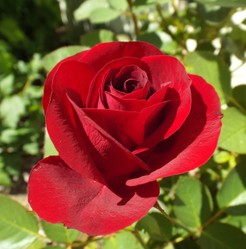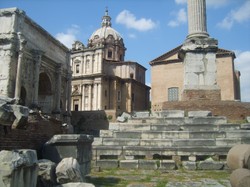The monastic life thrives in peace. Monasteries rely on a peaceful..society around them. They are not like castles, which only exist where there are potential conflicts with the neighbours. Monasteries not only like a peaceful external ambience, but they need to be places where the inmates dwell peacefully with each other. Otherwise there is no point to them. So the monastic garden is a place where people pray, study and interact with each other in peace. But we cannot confine Christian gardens to monasteries, for religious institutions are not only monasteries, and not all religious gardens are monastic. Seminaries, where people study to be priests, also have their gardens, and so do convents of nuns. Islamic gardens have their own individuality, for they while the Muslim faith bans images, the Islamic garden is laid out according to a geometrical pattern, in which the mathematically precise pattern reflects the controlling power of the divine mind, the order of creation.
Christian gardens are not designed with the same precision as Islamic gardens as there is greater variety in Christian gardens than there is in Islamic ones. The designers have in mind food, medicine, space for prayer and beauty.. The classic example of the Christian garden is Strabo's Hortulus, which is Latin for Little Garden. Abbot Strabo ruled an abbey on Lake Constance on the borders of Germany and Switzerland. His book , which is written in Latin verse details not only the plants in the garden, but the lay out. There is space for growing food, such as melons, and a variety of flowers grow, some for herbs, often medicinal, but at others ornamental. The book Hortulus indicates that there were other monastic gardens at other monasteries and there seems to have been correspondence between the monasteries about gardening.
The model for a monastery was the abbey of St Gall in Switzerland which was founded by the fiercely ascetic Irish monk Columbanus and later named after one of his monks. The design involves a... paradise garden. Paradise gardens have been associated with Islam, but this design is not Iunique to Islam, for there is a Christian tradition of paradise gardens, though Christian gardens do not follow the Islamic design. The aim of the Christian design is to replicate Eden. In fact, replicating Eden to help in the work of Christ in combatting origiinal sin, the sin committed by our first parents, Adam and Eve. The paradse garden is a place of beauty, adorned with flowers. This garden is often close to the church
Related the paradise garden is rge Marian Garden. This specializes in flowers which legend relates to Mary the mother of Jesus.white colours sometimes stand for Mary's purity and blue is often a colour linked to her. Many such flowers are linked with ancient legends remade from their preChristian roots to fitna place in Christian legend. Lilies are often used in the Marian culture.




 TheThousand Year Garden28 days ago
TheThousand Year Garden28 days ago
 Women of the Gospelson 10/11/2025
Women of the Gospelson 10/11/2025
 Doctor of the Church: John Henry Newmanon 08/03/2025
Doctor of the Church: John Henry Newmanon 08/03/2025
 Restoring the Palm Houseon 07/16/2025
Restoring the Palm Houseon 07/16/2025



Comments
The second subheading deals with edible gardens.
Did community diets or religious beliefs and traditions or both drive which plant dwelt there?
Great insightful piece.
I could use a picture of your Mary garden. If you can send it on line. I could put it in the article
Excellent
I put in mind of St David, the patron saint of Wales. He got his priests to grow and eat vegetables and that is why the leek is one of the symbols of Wales. .
I do a Mary garden with the children at church every May ,